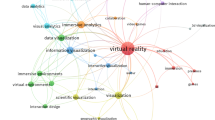Abstract
In this paper we present a method for sharing interactive and dynamic 3D models that are collaboration-unaware, i.e., models that have not been designed to be used by multiple users at the same time. This functionality is an essential requirement for the inclusion of arbitrary 3D models, as generated by standard CAD or animation software, into teleconferencing sessions. A key aim of this work is to show that a large part of the required functionality can be developed in a way so that it is reusable for other applications such as shared whiteboards or networked computer games. Our method therefore consists of both an application dependent part that handles the specific tasks required for sharing 3D models, and of a number of generic services such as synchronization, scalable support for latecomers, and the ability to record and replay sessions. The generic services are based on an abstract media model and the RTP/I application level protocol for distributed interactive media. Any other application for a medium that shares this model and that uses RTP/I may reuse these generic services. We have implemented a prototype called TeCo3D demonstrating the feasibility of our approach.
Similar content being viewed by others
References
A.L. Ames, D.R. Nadeau, and J.L. Moreland, VRML 2.0 Sourcebook, 2nd edition, John Wiley & Sons, New York, 1997.
Blaxxun. baxxun Contact, http: //www.blaxxun.com/products/contact/index.html.
D.P. Brutzman, “The virtual reality modeling language and Java,” Communications of the ACM, Vol. 41, No. 6, pp. 57–64, 1998.
S. Floyd, V. Jacobson, C. Liu, S. McCanne, and L. Zhang, “A reliable multicast framework for light-weight sessions and application level framing,” in IEEE/ACMTransactions on Networking,Vol. 5, No. 6, pp. 784–803, 1997.
V. Hilt, M. Mauve, C. Kuhmünch, and W. Effelsberg, “A generic scheme for the recording of interactive media streams,” in Proc. of the International Workshop on Interactive Distributed Multimedia Systems and Telecommunication Services (IDMS)'99, Toulouse, France, M. Diaz et al. (Eds.), LNCS 1718, Springer Verlag, Berlin, Germany, 1999, pp. 291–304.
W. Holfelder, “Interactive remote recording and playback of multicast videoconferences,” in Proc. of the International Workshop on Interactive Distributed Multimedia Systems and Telecommunications Services (IDMS)'97, Darmstadt, Germany, R. Steinmetz and L. Wolf (Eds.), LNCS 1309, Springer Verlag, Berlin, Germany, 1997, pp. 450–463.
V. Jacobson, S. Casner, R. Frederick, and H. Schulzrinne, RTP: A Transport Protocol for Real-Time Applications, Internet Draft, Audio/Video TransportWorking Group, IETF, draft-ietf-avt-rtp-new-04.txt, 1999.Work in progress.
C. Kuhmünch, T. Fuhrmann, and G. Schöppe, “Java teachware—The Java remote control tool and its applications,” in Proc. of ED-MEDIA/ED-TELECOM'98, Freiburg, Germany, 1998, available on CD-ROM.
L. Lamport, “Time, clocks, and the ordering of events in a distributed system,” Communications of the ACM, Vol. 21, No. 7, pp. 558–565, 1978.
M. Mauve, “TeCo3D: a 3Dtelecooperation application based onVRMLand Java,” in Proc. of SPIE Multimedia Computing and Networking (MMCN)'99, San Jose, CA, USA, published by SPIE, Bellingham, Washington, USA, 1999, pp. 240–251.
M. Mauve, “Consistency in continuous distributed interactive media,” in Proc. of ACM CSCW2000, Philadelphia, USA, 2000, pp. 181–190.
M. Mauve, V. Hilt, C. Kuhmünch, J. Vogel, W. Geyer, and W. Effelsberg, RTP/I: An Application Level Real-Time Protocol for Distributed Interactive Media. Internet Draft: draft-mauve-rtpi-00.txt, 2000. Work in progress.
M. Mauve, Distributed Interactive Media. Ph.D. Thesis, University of Mannheim, Lehrstuhl für Praktische Informatik IV, Mannheim, Germany, 2000.
Microsoft. Netmeeting Product Page, March 2000. http: //www.microsoft.com/windows/netmeeting.
D.L. Mills, Network Time Protocol (Version 3) specification, implementation and analysis. DARPA Network Working Group Report RFC-1305, University of Delaware, 1992.
W. Minenko, Advanced Design of Efficient Application Sharing Systems under X Window. Ph.D. Thesis, Department of Computer Science, University of Ulm, 1996.
SoftWired. iBus web pages. http: //www.softwired.ch/ibus.
J. Sonstein, VNet Web Page. 1999. http: //ariadne.iz.net/~jeffs/vnet/.
J. Robinson, J. Stewart, and I. Labbe, “MVIP-audio enabled multicast VNet,” in Proc. of the VRML2000 Symposium on the Virtual Reality Modeling Language (VRML), Monterey, California, USA, published by ACM SIGGRAPH, New York, USA, 2000.
C. Sun and C. Ellis, “Operational transformation in real-time group editors: Issues, algorithms, and achievements,” in Proceedings of the ACM1998 conference on Computer Supported Cooperative Work (CSCW'98), Seattle, Washinton, USA, 1998, pp. 59–68.
J. Vogel, M. Mauve, W. Geyer, V. Hilt, and C. Kuhmünch, “Ageneric late-join service for distributed interactive media,” in Proc. of ACM Multimedia 2000, Los Angeles, CA, USA, 2000.
J. Vogel, Multimedia Lecture Board Homepage, 2001. On-line: http: //www.informatik.uni-mannheim.de/ informatik/pi4/projects/ANETTE/anetteProject2.html.
VRML Consortium. Information technology—Computer Graphics and Image Processing—The Virtual Reality Modeling Language (VRML)—Part 1: Functional Specification and UTF-8 Encoding, ISO/IEC 14772-1: 1997 International Standard, 1997. http: //www.vrml.org/Specifications/.
VRML Consortium. LivingWorlds-Making VRML 2.0 Applications Interpersonal and Interoperable-Draft 2, April 1997. On-line: http: //www.vrml.org/WorkingGroups/living-worlds/draft 2/index.htm.
VRML Consortium. Information Technology—Computer Graphics and Image Processing—The Virtual Reality Modeling Language (VRML)—Part 2: External Authoring Interface. ISO/IEC 14772-2: 1999 Committee Draft, 1999. http: //www.vrml.org/WorkingGroups/vrml-eai/Specification/.
VRML Consortium. The VRML-Java3D Working Group, 1999. On-line: http: //www.vrml.org/WorkingGroups/vrml-java3d/.
Web3D Consortium. X3D Web page. http: //www.web3d.org/x3d.html.
Author information
Authors and Affiliations
Rights and permissions
About this article
Cite this article
Mauve, M. TeCo3D—Sharing Interactive and Dynamic 3D Models. Multimedia Tools and Applications 20, 283–304 (2003). https://doi.org/10.1023/A:1024076306065
Issue Date:
DOI: https://doi.org/10.1023/A:1024076306065




